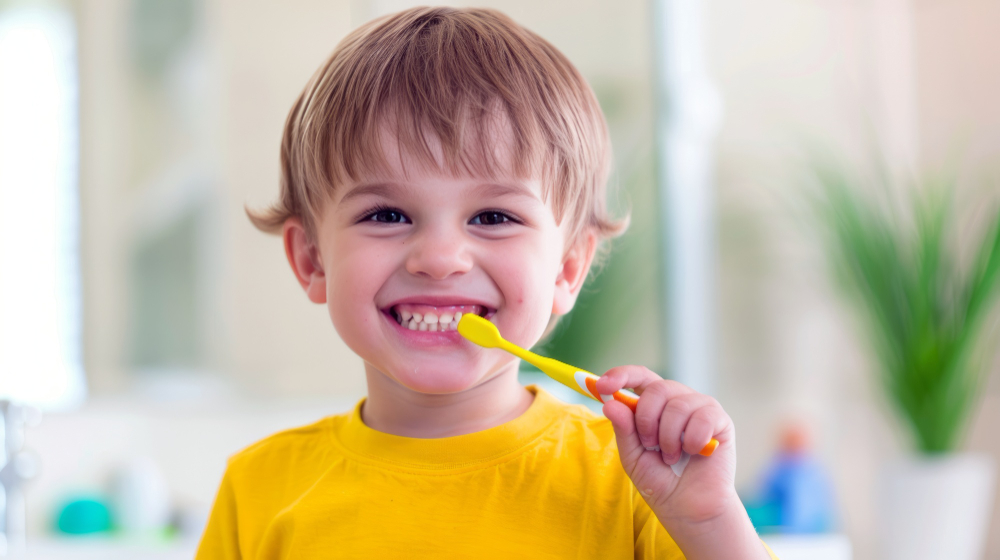모바일 칫솔질 교육 효과 번역(한국어 원본)한국의 평균수명이 2010년도에 80.8세로 늘어남에 따라(구성회 등, 2014) 만 6세 전후에 제1대구치가 나오는 영구치의 시기(이상호 등, 2013)를 감안하면, 일생동안 영구치를 사용하는 기간은 70년이 넘는 오랜 기간이다. 이렇게 장시간 동안 사용하는 영구치의 역할은 매우 중요하며, 영구치가 나오는 아동기는 구강건강의 관리가 중요한 시점이 된다.
본 연구에서는 만3~5세의 총 85명 아동 중 32명(연구군)은 모바일 칫솔질 교육 모니터링의 시행 후 구강건강 행위, 구강 증상과 구강건강관련 삶의 질 향상 및 구강관리능력 개선을 시키고자 하였다. 교육 장소에서 5회 칫솔질 교육만을 진행하는 미취학 아동 53명(대조군)과 무작위 배정하여 진행하였다. 교육 전, 교육 후 4주, 교육 후 8주의 변화는 구강건강 행위와 치면세균막 검사를 통하여 측정하였고, 교육 전과 교육 후 8주의 구강건강생태를 관찰하였으며, 칫솔질 교육 전 대상자들의 구강건강상태는 두 집단 간 차이가 없었다.
연구 결과, 치면세균막 지수는 칫솔질을 교육하기 전에 비하여 교육 후 4주, 교육 후 8주에 두 집단 모두 시간과 집단에 따라 개선되었으며, 교육 장소에서 가정으로 연계된 칫솔질 교육은 치면세균막 지수가 더 많이 개선되었다. 구강건강행위는 칫솔질 시간에는 차이가 없었으나 칫솔질 횟수에 대한 차이가 있었다. 구강건강 상태는 교육 전과 교육 후 8주에 우식유치치아, 충전유치치아, 우식경험유치치아에서 시간적인 차이는 있었으나 집단 간에는 차이가 없었다.
이상의 연구 결과 가정에서 연계한 모바일 칫솔질 교육 모니터링이 반복적 칫솔질 교육으로 치면세균막 지수와 칫솔질 방법, 칫솔질 횟수 등에 유의한 영향을 미치는 것을 알 수 있다. 단기성이 아닌 반복 교육과 교육 장소에서 뿐 만 아니라 가정에서도 계속된 올바른 칫솔질 교육이 더 효과적이라는 것을 의미한다. 따라서 미취학 아동을 대상으로 구강보건을 수행할 경우에는 일회성이 칫솔질 교육보다는 지속적이고, 반복적인 칫솔질 교육이 치면세균막 지수의 감소와 구강건강행동의 변화에 효과적이며, 구강건강행동을 변화시키는데 효율적이라고 사료된다. |
모바일 칫솔질 교육 효과 번역(영어 번역본)Average lifespans in Korea are extending to 80.8 years as of 2010 (reported by Gu Seong-hwe, et al. 2014) and taking into consideration the period when permanent teeth first appear with the first molar emerging around 6 years of age (Lee Sang-ho, 2013), the period of use of permanent teeth during a lifetime would be for a period of greater than 70 years. The permanent teeth that will be used during this extended period of time play a very important role, and childhood, the time when permanent teeth emerge, is a crucial time for managing dental health.
In this study the oral health behavior, oral symptoms and oral health related improvments in the quality of life and oral hygiene performance of a total of 32 (research group) out of 85 children ages 3~5 years old had improved. The study was performed through a random allocation of 53 preschool-aged children (control group) that received 5 tooth brushing education sessions carried out at the education center. Changes were measured by assessing conditions prior to the education, 4 weeks post-education, and 8 weeks post-education through an oral health behavior and a plaque evaluation, and after observing the oral health condition prior to the education and 8 weeks post-education it was found that there was no difference in the oral health condition of the two groups compared to the time prior to the toothbrushing education.
The results for the plaque index showed that when compared to the time prior to receiving education on toothbrushing there was an improvement in the group 4 weeks post-education, and the group 8 weeks post-education, and the dental plaque index improved when toothbrushing education was continued in the home. Toothbrushing durations made no difference in oral health behavior, but the frequency of toothbrushing did make a difference.
With the oral health condition there was a temporal difference with the dt index, ft index, and dft index comparing the time prior to the education and 8 weeks post-education, but there was no a difference between the groups. The results of the above study found that having mobile toothbrushing education and repetitive toothbrushing education continue in the home showed a significant effect on the dental plaque index, tooth brushing methods and toothbrushing frequency. This means that repetitive education at an education center along with correct toothbrushing education in the home is more effective than short term education. Accordingly, when oral health is performed for preschool-aged children ongoing education is considered more effective than non-recurrent toothbrushing education for reducing the dental plaque index, for changes in oral health behavior, and for creating changes in oral health behavior. |
